Abstract
In this work, we propose a novel multiband meander line antenna that can operate at three different frequency bands and offer suitable performance for wireless body area network (WBAN) applications. The net geometry of the antenna is 36 × 30 × 1.524 mm. The proposed low-profile antenna is analytically modeled and designed in full wave ANSYS HFSS using Rogers TMM4 as the substrate, followed by in-lab prototyping. The designed antenna resonates at 4.5 GHz, 5 GHz, and 5.8 GHz and maintains positive gain, efficiency, and acceptable specific absorption rates at each resonant band. The effectiveness of the antenna for WBAN applications is demonstrated using an in-lab manufactured phantom. The fabrication process of the phantom is described, and dielectric characterization of the phantom mimicking different human tissue layers is presented. Considering results with and without human body phantoms available in the full wave ANSYS HFSS tool, a comparative analysis between simulated and measured antenna parameters concludes this work. Both the simulated and measured results show good agreement.
1. Introduction
Over the past decade, as wireless body area network (WBAN) systems have received immense recognition and interest for their versatile applications in the health monitoring, military, and entertainment sectors, advanced research related to on-body or off-body communication links is advancing [1,2]. In a typical WBAN system, an antenna is required to communicate wirelessly, and such antennas are mounted on the human body while communicating with external devices. However, due to restrictions on their size, substrate properties, shape, and efficient performance, designing antennas for WBAN applications in versatile radiofrequency (RF) environments is challenging. As the RF environment changes with the wearer’s age and posture, only noncorrosive and biocompatible materials can be used, resulting in poorer performance. Furthermore, the shape and size of an antenna depend on its location over the organ and this may limit the freedom of design. Recently, a small amount of research has been published on designing antennas that are suitable under such circumstances [3,4]. Moreover, as the radiation pattern needs to be normal to the body to ensure high antenna performance [5], a variety of approaches have been developed over the years with the aim of achieving such design objectives. However, broadband and multiband antennas are becoming more preferred due to their multiple functions; multiband antennas are suitable for globally recognized cellular technologies such as global systems for mobile (GSM) communication and long-term evolution (LTE). For example, omnidirectional dual-band multiple-input multiple-output (MIMO) antennas (698–960 MHz, 1710–2700 MHz) are a good fit for 4G/LTE GPS technologies. Omnidirectional dual-band dipole antennas used in the 850–900 MHz frequencies and the 1800–2100 MHz frequency ranges are suitable for GSM. In [6], researchers proposed a compact microstrip patch antenna fed through an inset transmission line, with two triangles loading the antenna to lengthen the current path. Although the antenna resonated at 2.45 GHz, its large dimensions of 62 × 43 × 1.67 mm and single band operation made it unsuitable for wearable applications. In [7], another study presented a multiband wearable monopole patch antenna integrated with a defective ground structure that operates over four distinct frequencies: 2.12 GHz, 4.78 GHz, 5.57 GHz, and 6.11 gmHz. Though the antenna provided a high gain of up to 10.7 dBi, its specific absorption rate (SAR) analysis has not been examined. However, there can be a significant impact on antenna performance due to SAR. Moreover, in [8], the authors presented a microstrip patch antenna on nonconductive material along with a 1.6 mm thick FR-4 substrate. Although this work represented a stable SAR value, the single-band operation and larger footprint still gave rise to the need for a multiband antenna.
In one of the most recent papers, [9], researchers have proposed a low-profile all-textile multiband antenna where an elliptical slot and a C-shaped slot were employed to tune the desired operating frequency bands. The use of a conductive fabric (textile) layer makes this antenna extremely low profile, with a size of 60 × 60 × 1.17 mm. The entire ground plane enabled it to fulfill the SAR limit set by the Federal Communications Commission (FCC), 2 W/kg, which indicates that the proposed design is a promising candidate for WBAN applications. However, the radiation pattern analysis considering the human tissue layer and measurements on the actual tissue system have yet to be discussed for this proposed design [10]. In recent works, such as [11], researchers proposed a wearable antenna that covers the 2.4 GHz/5.2 GHz/5.8 GHz WLAN, 3.5 GHz WiMAX, and 4.4 GHz C-bands. The prototyped antenna has overall dimensions of 60 × 40 × 0.254 mm along with reasonable gain and SAR. Moreover, newly emerging 3D-printed conformal antennas can also be good candidates for WBAN applications [12].
In this paper, a detailed analysis is carried out by analyzing the performance of a multiband antenna considering different parts of the human body using a phantom. For such measurements, the phantom mimicking different tissue layers was fabricated in the lab. Both off- and on-body antenna performance are discussed. Specifically, a systematic analysis was performed with the antenna mounted on or near human body parts. The antenna also demonstrated a reasonable performance in on-body conditions. However, degradation of the antenna’s performance was observed when the antenna was placed near the human body. The possible reasons for such degradation are also briefly discussed in this paper. At each resonance frequency, the antenna provided an efficient performance that makes it a suitable candidate for WBAN applications. Table 1 summarizes a comparative analysis between a few related PCB-based designs reported in published literature and the design proposed by the authors in this paper.

Table 1.
Comparison between the proposed multiband antenna frequency bands with some of the previously reported works.
The presented antenna resonates at the following ISM band frequencies: GHz, 5 GHz, and GHz. These frequency bands are specifically chosen in this design for use in military fixed and mobile communications, such as point-to-point microwave links, and telemetry applications, such as unmanned aerial vehicles (UAV), in the US and NATO countries along with relevant antenna body applications. As existing wireless applications such as baby monitors, security cameras, microwave appliances, garage door openers, etc. using WiFi and Bluetooth technologies have already overcrowded the popular GHz at ISM band, the authors intentionally designed the antenna presented here not to resonate at GHz in order to avoid potential electromagnetic interference issues. This practice has already been adopted in several military and medical technologies for recent wireless body area network applications. Additionally, it must be noted here that the novelty of this proposed design is not focused on its meandered line structure, which is already a well-established topic, but rather on enabling useful radiation (E- and H- fields; gain) properties at each of the three resonant ISM band frequencies of this low-profile antenna with an acceptable SAR value for wireless body area network applications across the world.
2. Antenna Topology and Design
In this section, the design concept of the basic meander line antenna is shown. There are three sub-sections: multiband antenna design, current distribution, and the antenna fabrication process.
2.1. Triple Band Antenna Design
The design of the proposed antenna is depicted in Figure 1. The construction of the proposed antenna starts with a simple microstrip patch antenna that is not shown in Figure 1. The antenna design and structures went through several evolution processes to achieve multiple resonant frequencies. The third antenna, as shown in Figure 1, is the finalized one used for this work. In order to enable multiple resonant frequencies, some slots were introduced on the patch and the parameters were observed. These slots aid the antenna to redistribute the surface current through the radiating metal, thus resulting in multiple operating bands.

Figure 1.
Evolution of the proposed antenna through simulation in Ansys HFSS.
The slot length (L) and width (W) of the antenna, considering a nonmagnetic substrate material, is calculated based on the equations below [16]:
where W = width of the slot, = required resonant frequency, = permittivity of free space, = permeability of free space, and = dielectric constant of the substrate. The effective dielectric constant is also required to calculate the slot length
where h is the height of the substrate. The slot length (L) was determined by the following equation:
where can be determined from the substrate height, slot width and effective dielectric constant, as shown in the equation below.
It must be noted here that, although incorporating multiple slots on the patch resulted in three resonant frequencies in the final design, the first two antennas as shown in the evolution process did not provide the desired matching and acceptable reflection coefficient parameters at the desired resonant frequencies. To achieve the desired matching with acceptable parameters at the three resonance frequencies, the dimensions of slot length () and width () of the design, as shown in Figure 2 along with labeled arrows, were achieved based on Equations (1)–(4). Some minor adjustments based on the optimization methods described in [17,18,19] were also carried out in Ansys HFSS, specifically for the third arm of the final design. Figure 3 and Table 2 summarize the detailed guideline of the final antenna design. The full-wave simulated magnitudes of the reflection coefficient () of the antenna designs throughout the evolution steps are shown in Figure 4.
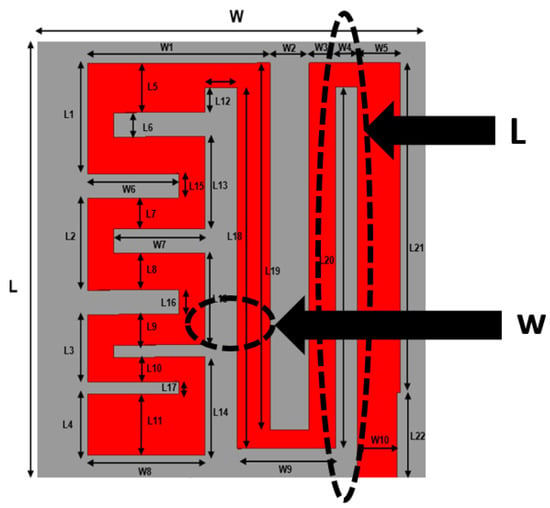
Figure 2.
Design analysis of the proposed antenna in Ansys HFSS.
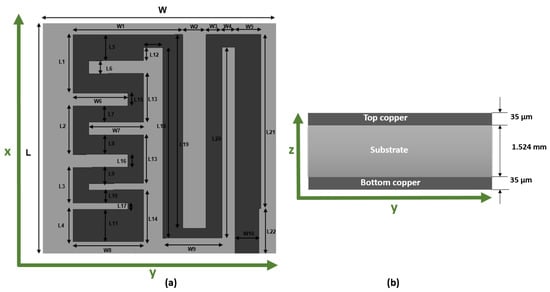
Figure 3.
(a) Dimensions of the proposed antenna, (b) cross-section of the proposed antenna.

Table 2.
Design parameters of the proposed antenna, all in mm.
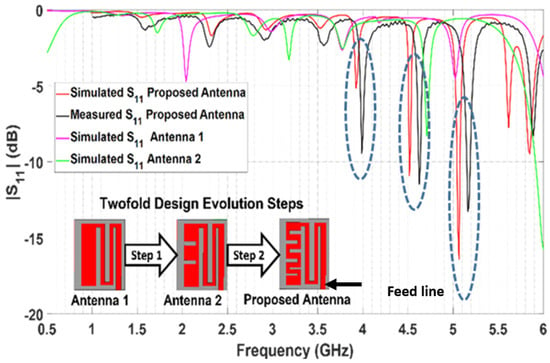
Figure 4.
Analysis of parameters in the evolution process of the proposed antenna [20].
2.2. Determination of Surface Current Distribution
For a better insight into the working principle of the antenna, the surface current distribution was analyzed at GHz, 5 GHz, and GHz, as shown in Figure 5. Here, the surface current indicates the actual electric current induced by an applied electromagnetic field at the input port of the antenna. The surface current density is directly proportional to the electric field, as shown in the equation below where is the electric field in V/m and is the conductivity in S/m of the material used.

Figure 5.
Surface current distribution of the proposed antenna at (a) 4.515 GHz, (b) 5.065 GHz, (c) 5.8487 GHz.
From Figure 5, one can observe that at GHz, the surface current is concentrated on all four arms of the antenna, which implies that the entire antenna radiates at that frequency. However, in the case of the GHz frequency band, the currents are mostly concentrated on the first two arms of the antenna, and at 5.8487 GHz, the current is mostly distributed through the first three arms. Thus, the whole antenna contributes to resonating at GHz, whereas the first two arms and the second arm from the right contribute to 5.065 GHz and 5.8487 GHz, respectively.
2.3. Prototype Fabrication
The demonstrated antenna, as shown in Figure 6, was fabricated on a double-side Cu cladded Rogers TMM4 substrate (, ) with a net compact geometry of mm. The antenna was prototyped using an LPKF Laser Electronics S103 milling machine.
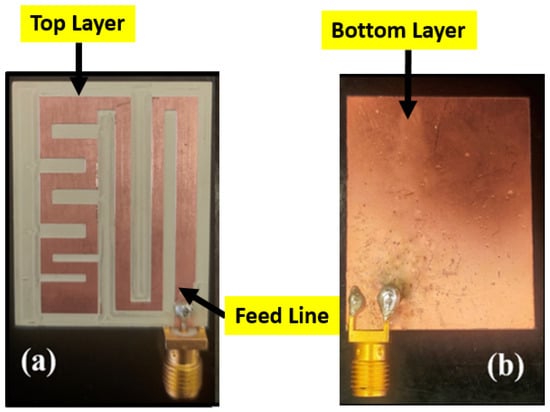
Figure 6.
Prototyped multiband antenna: (a) top plane or layer and (b) bottom plane or layer.
3. Off-Body Antenna Measurements and Discussion
3.1. Parameter Analysis
To validate the simulated results, the parameters of the antenna were measured using a calibrated Keysight E8361c vector network analyzer (VNA). The simulated and measured values were in fair agreement, as shown in Figure 4. Moreover, in Figure 4, it can be observed that the simulated and measured parameters of the antenna in the free space were below dB at GHz and GHz, establishing a good impedance matching where more than of power was being delivered at the antenna at these two frequencies. However, the simulated and measured parameters of the antenna in free space were not below dB, but rather were measured around dB at GHz, establishing a fair impedance matching where nearly of power was being delivered at the antenna at that frequency. This limitation of the antenna while being operated in free space would disappear later when the simulated and measured parameters of the antenna were demonstrated for on-body applications in Section 4.
3.2. Antenna Gain and Efficiency
This section discusses realized gain and simulated efficiency of the antenna.
3.2.1. Realized Gain
Figure 7 represents the overall realized gain of the antenna at all three resonant frequencies. The maximum realized gains of the proposed antenna were 3 dBi, 6.96 dBi, and 2.3 dBi at 4.515 GHz, 5.065 GHz, and 5.848 GHz, respectively.
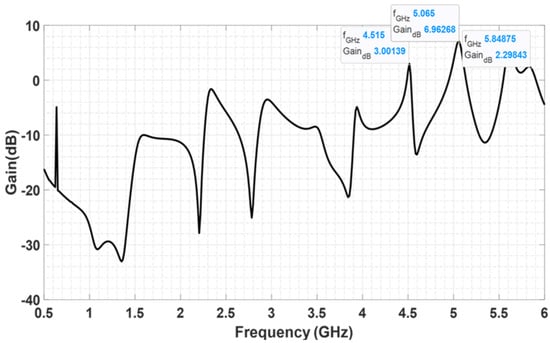
Figure 7.
Realized gain of the multiband antenna at (a) 4.515 GHz, (b) 5.065 GHz, and (c) 5.8487 GHz.
3.2.2. Simulated Efficiency
The designed antenna also provides reasonable simulated efficiencies at the resonating frequencies, as summarized in Table 3.

Table 3.
Efficiency of the proposed antenna.
3.3. Radiation Patterns
The far-field radiation patterns of the low-profile meander line antenna were analyzed in Ansys HFSS and measured in an anechoic chamber. A DP240-AB broadband (2–18 GHz) horn antenna was used during the measurement as a fixed gain transmitter located at the far-field distance, as shown in Figure 8. According to Figure 9b, the proposed multiband antenna has linear polarization, mostly along the E—plane and in part along the H—plane, at all three resonant frequencies. The measured radiation patterns of the fabricated antenna exhibit directional behavior with a little back lobe at 4.52 GHz and 5.07 GHz and an omnidirectional behavior at 5.85 GHz, implying its suitability for external WBAN applications. A decent consistency can be observed between the simulation and measurement results shown in Figure 9a.
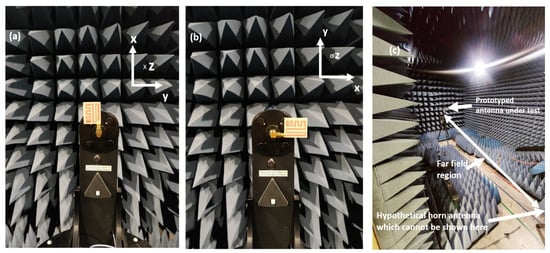
Figure 8.
(a) E-plane (Y-Z), (b) H-plane (X-Z), and (c) antenna under test in an anechoic chamber.
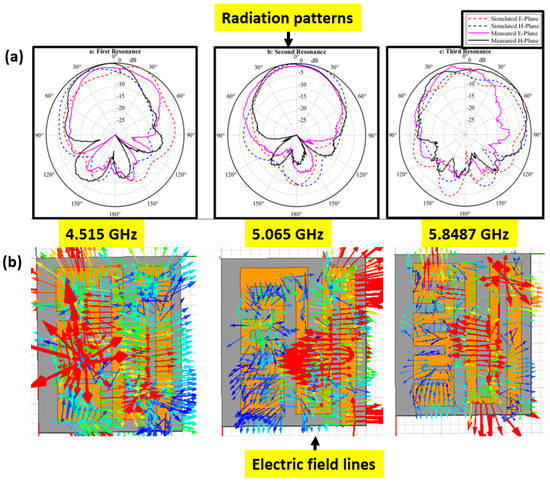
Figure 9.
(a) Simulated and measured radiation patterns and (b) simulated E field lines at 4.515 GHz, 5.065 GHz, and 5.8487 GHz.
4. Antenna Performance Analysis on a Phantom Mimicking Human Body
As the antenna was designed for WBAN applications, its overall performance was analyzed both in free space and on phantoms. This is because the human body tissues absorb and re-radiate some portion of the electromagnetic energy from the antenna, thus affecting the overall antenna performance. Moreover, the separation between antenna and phantom was varied and different antenna parameters such as gain, SAR, and radiation patterns were analyzed. It was observed that the antenna parameters improved at a certain minimal separation from the human body.
4.1. 3D Tissue Model Creation and Optimum Distance Analysis
To understand the composite human body’s characteristics in relation to EM wave radiation, a 3D human tissue layer was modeled in Ansys HFSS, as shown in Figure 10. The average relative permittivity, conductivity, loss tangent, and density of different tissue types at 4 GHz, 5 GHz, and 5.8 GHz are shown in Table 4. Throughout this work, four distinct separations of the antenna from the human body were considered. When the antenna was placed very close to the human body, the value was observed to be above dB, thus yielding a poor matching due to reactive loading by the body. Another possible reason behind this observation was that when the antenna was closely placed, the input impedance of the antenna might be changed due to the fringing effect. Moreover, such fringing effect might change the effective width of the antenna structure and thus shift the resonant frequency based on the equation below:
where c = speed of light in free space, = dielectric constant of the substrate, d = width of the substrate. Based on the above observations, and considering the convenient placement of such an antenna over a jacket or suit rather than in direct contact with the human body for conventional WBAN applications, a distance of 6 mm between the antenna and the human skin was adopted in this study as a reasonable consideration, as shown in Figure 10. It must be noted here that the operating frequency of the antenna at such a minimal distance was still observed to be shifted; however, it remained satisfactorily well below dB, as shown in Table 5 and Figure 11.
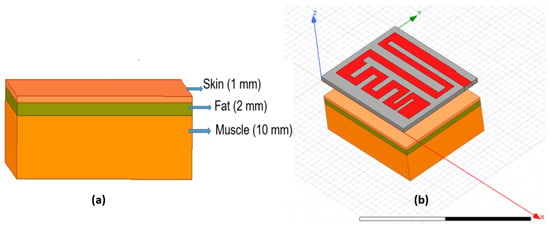
Figure 10.
(a) 3D tissue model, (b) antenna on tissue layer at a distance of 6 mm.

Table 4.
Properties of human tissue.

Table 5.
Measurement of at different distances.
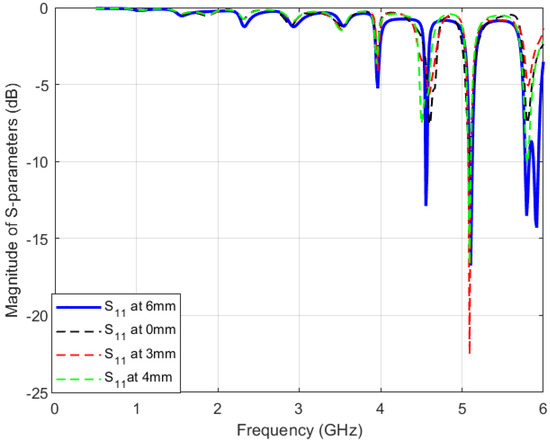
Figure 11.
Measured and simulated at different separations of the antenna from the human body.
4.2. In-Lab Fabrication of the Phantom Mimicking Human Body
To enable a better insight into the antenna performance for WBAN applications, it was necessary to perform characterizations on a hypothetical human body. For this purpose, different phantom tissues were fabricated following protocols inspired by [21] due to the limitation of commercially available phantoms. The basic ingredients needed to fabricate the phantom are listed in Table 6. Specifically, the proportions of ingredients such as oil and gelatin were adjusted to get the accurate dielectric constant values where gelatin helped to congeal the mixture, NaCl determined the conductivity, and oil in water mimicked the cell-to-cell adherence along with its natural property as fat. Several trials of the fabrication process were attempted to achieve the desired dielectric constants for each tissue type. For example, in the initial stages, the existence of air bubbles and the inhomogeneous mixture were responsible for unreasonable output. Therefore, in the following stages, several filtration processes were performed to remove trapped air bubbles and ensure homogeneous mixtures, as shown in Figure 12.

Table 6.
Ingredients of tissue-mimicking phantoms.

Figure 12.
Tissue-mimicking phantom creation.
Dielectric Constant Measurement of the Fabricated Phantoms
Followed by the fabrication process, the dielectric constant of the developed phantom was measured using a Keysight N1501A Performance Probe at room temperature, as shown in Figure 13. Here, the calibrated dielectric probe was connected to the VNA, and the net thickness of the phantom was 10 mm. As shown in Table 7, there is a fair level of agreement between the measured and theoretical dielectric constant values for skin and muscle tissues. Despite numerous trials, attempts to mimic fat tissues using the proposed method appeared to fail. Hence, the authors would like to acknowledge this as a limitation of their proposed fabrication method. Therefore, only skin and muscle tissues were considered for measured characterizations of the proposed antenna for WBAN applications hereafter.
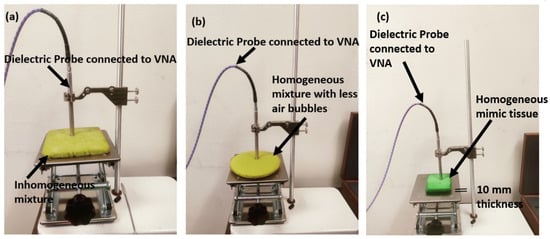
Figure 13.
Dielectric constant measurements of the fabricated phantom: (a) first trial, (b) intermediate trial, and (c) final prototype of the fabricated phantom.

Table 7.
Comparison between measured and theoretical dielectric constants for skin and muscle phantoms.
4.3. On-Body Simulated and Measured Results Analysis
4.3.1. Measured and Simulated Reflection Coefficient ()
Next, the magnitude of the reflection coefficient (||) of the proposed antenna on the developed phantom was analyzed in Ansys HFSS and measured using the VNA where the antenna was connected to Port 1 of the VNA. To maintain a separation of 6 mm between the antenna and the phantom, a rectangular piece of Styrofoam with similar thickness was placed between the antenna and the phantom, as shown in Figure 14. Styrofoam has a dielectric constant of close to 1 at free space for a frequency range of 1–10 gmHz, which makes it suitable to utilize as an alternative to air. The observations are summarized as follows: (i) all three resonant frequency points of the antenna appeared to be minimally shifted in the measurement; (ii) at each resonant frequency point, the still appeared well below dB, thus yielding a good impedance match; and thus, (iii) the measurements validated the overall presented work.
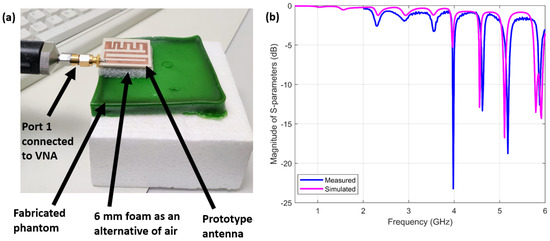
Figure 14.
(a) Setup of the prototyped multiband antenna on the fabricated phantom during reflection coefficient measurements, (b) comparison between measured and simulated values.
4.3.2. Antenna Efficiency and Gain
Gain
When the antenna was set at a separation of 6 mm from the phantom in simulation, the resonant frequency marginally shifted to higher values. Because the antenna was designed to operate at 4.515 GHz, 5.065 GHz, and 5.8487 GHz, the gain was still analyzed for those operating frequencies. Based on the observations from Figure 15, the antenna gain was almost identical at 5.8487 GHz. However, the antenna gains for 4.515 GHz and 5.065 GHz were reduced in magnitude; which might happen due to some absorption of electromagnetic energy in the tissue layers of the phantom at these operating frequency points. Overall, a good impedance matching and a positive gain magnitude at each resonant frequency of the antenna for the on-body analysis make the antenna a reasonable candidate for versatile WBAN applications. The efficiency of the proposed antenna for such on-body performances is summarized in Table 8.
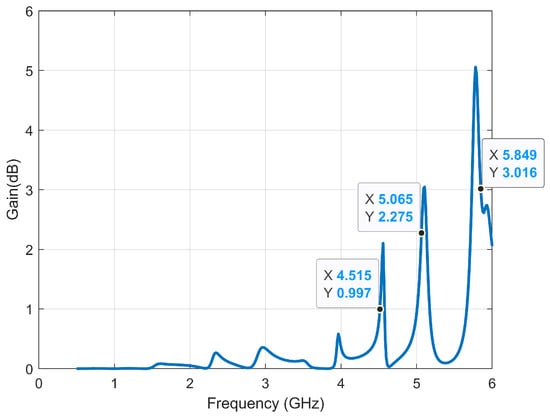
Figure 15.
Simulated antenna gain when placed near phantom with 6 mm of separation at 4.515 GHz, 5.065 GHz, and 5.8487 GHz.

Table 8.
Efficiency of the proposed antenna.
4.3.3. SAR Analysis
To analyze the effects of the proposed antenna on the human body, the SAR value was analyzed for each resonant frequency point. To measure the SAR values, a female left-hand component was considered against the proposed antenna in Ansys HFSS, as shown in the figures below. The distance between the antenna and the component was kept at 6 mm, and the female hand constituted specific conductivity, dielectric constant, and mass density. Due to the propagation of electromagnetic waves through the hand component, some absorption occurred, as the following results show. Overall, the obtained SAR values were successfully far below the limits defined by the US agency, the Federal Communications Commission (FCC), and the European agency, the International Commission on Non-Ionizing Radiation Protection (ICNIRP), at all three resonant frequency points. As a reference, the SAR limit must not exceed 1.6 W/kg per 1 gm mass of tissue according to the FCC, or 2 W/kg for 10 gm mass of tissue according to the ICNIRP.
SAR for 1 gm Limit
From the SAR distribution at the 1 gm standard, it was observed in our simulation that more electromagnetic radiation was absorbed than at 10 gm in the center of the antenna. As shown in Figure 16, the corresponding simulated maximum SAR values for 4.515 GHz, 5.065 GHz, and 5.8487 GHz were around 1.52 W/kg, 1.3 W/kg, and 1.45 W/kg, respectively, which clearly fulfill the FCC limit. It was also observed that for 4.515 GHz and 5.065 GHz, the SAR was slightly higher than 1.6 W/kg in some portions near the phantom. This could be due to the uneven structure of the human hand, meaning that in some areas, the distance was not exactly 6 mm. To provide a better understanding of the SAR performance of the proposed antenna, different phantom components were also considered in Ansys HFSS. A female left arm was considered for a 1 gm mass limit where the maximum values of SAR at 4.515 GHz, 5.065 GHz, and 5.8487 GHz were 1.54 W/kg, 1.13 W/kg, and 0.78 W/kg, respectively. Finally, as shown in Figure 17, the antenna successfully met the SAR limit set by the FCC for different phantom structures at all three resonant frequencies.
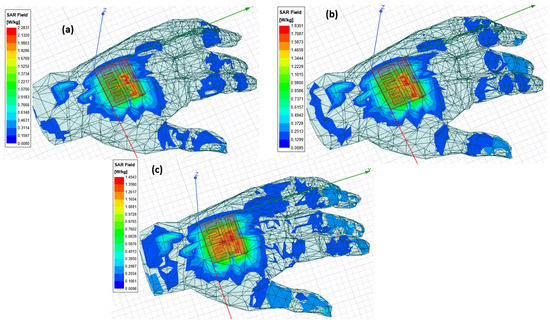
Figure 16.
Simulated SAR at (a) 4.515 GHz, (b) 5.065 GHz, and (c) 5.8487 GHz for 1 gm standard on a female left hand.
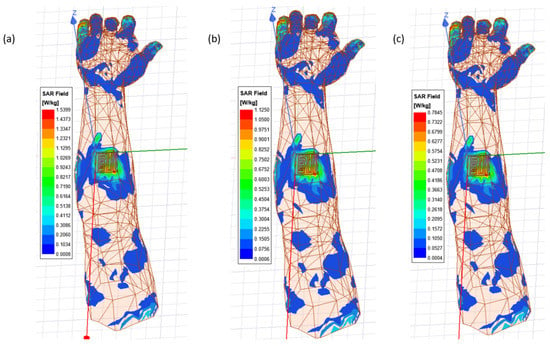
Figure 17.
Simulated SAR at (a) 4.515 GHz, (b) 5.065 GHz, and (c) 5.8487 GHz for 1 gm standard on a female left arm.
SAR for 10 gm Limit
From the SAR distribution at the 10 gm standard, it was observed that the maximum radiation was concentrated mostly in the center of the antenna. As shown in Figure 18, the corresponding maximum SAR values for 4.515 GHz, 5.065 GHz, and 5.8487 GHz were 1.05 W/kg, 0.92W/kg, and 0.89 W/kg, respectively, which are much lower than the ICNIRP limit. The SAR performance was analyzed on a female left arm phantom, as shown in Figure 19. For each resonant frequency, the prototyped antenna fulfilled the SAR limit specified by the ICNIRP; at 4.515 GHz, 5.065 GHz, and 5.8487 GHz the maximum SAR values were 0.68 W/kg, 0.515 W/kg, and 0.36 W/kg, respectively.
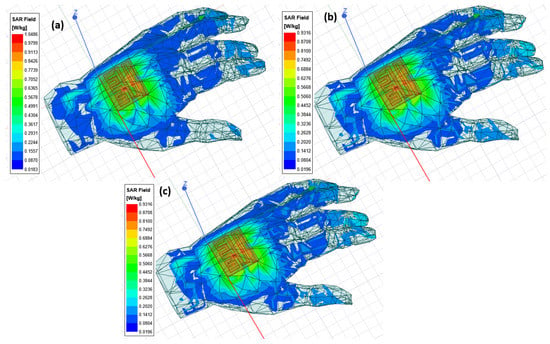
Figure 18.
Simulated SAR at (a) 4.515 GHz, (b) 5.065 GHz, and (c) 5.8487 GHz for 10 gm standard on a female left hand.
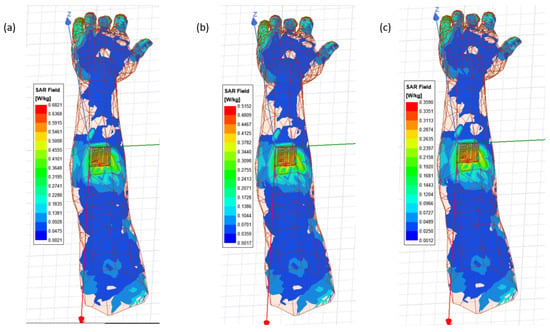
Figure 19.
Simulated SAR at (a) 4.515 GHz, (b) 5.065 GHz, and (c) 5.8487 GHz for 10 gm standard on a female left arm.
As shown in Figure 20, the observed electric field intensity values of the proposed antenna when placed on a phantom with a separation of 6 mm were lower than 61.4 V/m at each resonant frequency point, thus satisfying the FCC-mandated limit. This analysis could also be helpful for understanding the effects of electromagnetic coupling due to the antenna for such on-body applications.
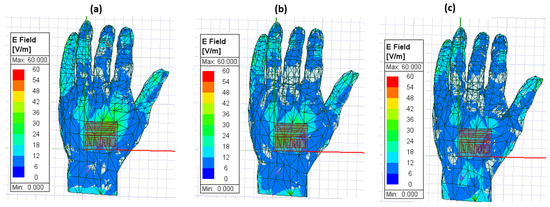
Figure 20.
Electric field intensity analysis of the proposed antenna when placed on a phantom with a separation of 6mm at (a) 4.515 GHz, (b) 5.065 GHz, and (c) 5.8487 GHz.
4.3.4. Radiation Pattern
The simulated radiation patterns of the proposed on-body antenna are shown in Figure 21. In general, the human body absorbs backward radiation by an antenna when the antenna is placed directly on or near the body, thus reducing the front-to-back lobe ratio (FBR) in the radiation patterns of the antenna. Here, the FBR indicates the ratio of radiated power in the main radiation lobe to the power radiated in the direction opposite to the main beam. Due to this absorption by the human body, the efficiency of the antenna also drops. For the designed antenna as shown in Figure 21, the simulated radiation efficiency decreased from 76.7% to 56.3%, 93% to 68%, and 91% to 71% at 4.515 GHz, 5.065 GHz, and 5.8487 GHz, respectively. Although the on-body efficiency of the proposed antenna decreases compared with the results obtained in free space, it can still be considered superior in comparison with other existing wearable antennas, such as [22,23]. It may be noted that because the directivity of the antenna deteriorates when it is integrated with the human body, its efficiency is also reduced at each operating frequency point. Finally, the combination of lower directivity and lower efficiency of the antenna on the human body leads to reduced simulated gains at all three resonant frequency points. However, the proposed antenna satisfactorily fulfills the SAR limits specified by the FCC and ICNIRP, thus making it a promising candidate for prospective WBAN applications.
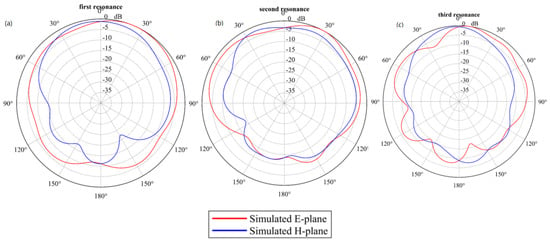
Figure 21.
Simulated radiation pattern of the proposed antenna on phantom with a separation of 6mm at (a) 4.515 GHz, (b) 5.065 GHz, and (c) 5.8487 GHz.
5. Conclusions
In this paper, a novel low-profile multiband meander line antenna was proposed, designed, prototyped, and measured for both off-body and on-body applications. This triple-band PCB-based antenna, although not flexible in geometry, can still be a suitable candidate for WBAN applications due to its small form enabling such a design to be wearable in different locations on the body, such as the back of the hand or arm. Continuity in positive gain performance by the antenna, both with and without phantoms, at all resonance points, was achieved. Because the antenna was designed to be mounted on the human body, it was a relevant issue to introduce a novel design that could perform reasonably even in the presence of the complex geometry of the human body. To do so, the antenna was precisely tested on a fabricated phantom, and the outcomes indicated the robustness of the antenna’s overall performance. The proposed multiband antenna was characterized theoretically and experimentally both with and without the consideration of human phantoms. Detailed analysis and different characteristics such as reflection coefficient, radiation patterns, gain, and efficiency were discussed for both conditions. Moreover, SAR analysis proved its capability as a wearable antenna application. Finally, the results and root cause analysis in this paper can be a good resource for analyzing the overall performance of the antenna when mounted on composite human body parts. The simulated results obtained using Ansys HFSS software and the measured results from the Keysight PNA series network analyzer prove that the proposed antenna can be a very convincing candidate for sensing and communications operations in WBAN applications.
Author Contributions
Conceptualization, S.R.; methodology, T.I. and S.R.; validation, T.I.; formal analysis, T.I.; investigation, T.I. and S.R.; resources, S.R.; data curation, T.I. and S.R.; writing—original draft preparation, T.I.; writing—review and editing, S.R.; visualization, T.I.; supervision, S.R.; funding acquisition, S.R. All authors have read and agreed to the published version of the manuscript.
Funding
This research is based upon work supported by the National Aeronautics and Space Administration (NASA) under Grant No. 80NSSC18M0022.
Data Availability Statement
Not applicable.
Conflicts of Interest
The authors declare no conflict of interest.
References
- Fourati, L. Wireless Body Area Network and Healthcare Monitoring System. In Proceedings of the 2014 IEEE International Conference on Healthcare Informatics, Verona, Italy, 15–17 September 2014; p. 362. [Google Scholar]
- Li, M.; Lou, W.; Ren, Q. Data security and privacy in wireless body area networks. IEEE Wirel. Commun. 2010, 17, 51–58. [Google Scholar] [CrossRef]
- Morris, S.; Chandran, A.; Timmons, N.; Morrison, J. Design and performance of a flexible and conformai PDMS Dipole antenna for WBAN applications. In Proceedings of the 2016 46th European Microwave Conference (EuMC), London, UK, 4–6 October 2016. [Google Scholar]
- Meher, P.; Behera, B.; Mishra, S.; Althuwayb, A. Design and analysis of a compact circularly polarized DRA for off-body communications. AEU Int. J. Electron. Commun. 2021, 138, 153880. [Google Scholar] [CrossRef]
- Liu, Z.; Guo, Y. IEEE Transactions on Antennas and Propagation. AEU Int. J. Electron. Commun. 2012, 61, 2282–2285. [Google Scholar]
- Jabbar, A.; Arif, A.; Zubair, M.; Riaz, K.; Mehmood, M. A Low-cost Photopaper Based Wideband Wearable Antenna for WBAN Applications. In Proceedings of the International Bhurban Conference on Applied Sciences & Technology (IBCAST), Islamabad, Pakistan, 12–16 January 2021. [Google Scholar]
- Roopan, D.; Samantaray, B.; Bhattacharyya, S. A Multiband Wearable Antenna with Defected Ground Structure. In Proceedings of the URSI Asia-Pacific Radio Science Conference (URSI AP-RASC), New Delhi, India, 9–15 March2019. [Google Scholar]
- Dey, A.; Mitra, D.; Arif, W. Performance Analysis of Microstrip Patch Antenna for the Diagnosis of Brain Cancer & Tumor using the Fifth-Generation Frequency Band. In Proceedings of the 2021 IEEE International IOT, Electronics and Mechatronics Conference (IEMTRONICS), Toronto, ON, Canada, 21–24 April2021. [Google Scholar]
- Li, H.; Du, J.; Yang, X.; Gao, S. Low-Profile All-Textile Multiband Microstrip Circular Patch Antenna for WBAN Applications. IEEE Antennas Wirel. Propag. Lett. 2017, 21, 779–783. [Google Scholar] [CrossRef]
- Seneviratne, S.; Hu, Y.; Nguyen, T.; Lan, T.; Khalifa, S.; Thilakarathna, K.; Hasan, M. A Survey of Wearable Devices and Challenges. IEEE Commun. Surv. Tutor. 2017, 19, 2573–2620. [Google Scholar] [CrossRef]
- Dey, A.; Mitra, D.; Arif, W. Design of CPW fed multiband antenna for wearable wireless body area network applications. Int. J. RF Microw. Comput. Aided Eng. 2020, 30, e22459. [Google Scholar] [CrossRef]
- Mitra, D.; Striker, R.; Cleveland, J.; Lewis, J.; Braaten, B.; Kabir, K.; Ye, S.; Roy, S. A Fully 3D-Printed Conformal Patch Antenna using Fused Filament Fabrication Method. In Proceedings of the 2020 IEEE International Symposium on Antennas and Propagation Society International Symposium), Montreal, QC, Canada, 5–10 July 2020. [Google Scholar]
- Tong, X.; Liu, C.; Guo, H.; Liu, X. A triple-mode reconfigurable wearable repeater antenna for WBAN applications. Int. J. Microw. Comput. Eng. 2019, 29, e21615. [Google Scholar] [CrossRef]
- Yan, S.; Vandenbosch, G.A. Radiation pattern-reconfigurable wearable antenna based on metamaterial structure. IEEE Antennas Wirel. Propag. Lett. 2016, 15, 1715–1718. [Google Scholar] [CrossRef]
- Tak, J.; Woo, S.; Kwon, J.; Choi, J. Dual-band dual-mode patch antenna for on-/off-body WBAN communications. IEEE Antennas Wirel. Propag. Lett. 2015, 15, 348–351. [Google Scholar] [CrossRef]
- Balanis, C. Antenna Theory: Analysis and Design, 4th ed.; Wiley-Interscience: Hoboken, NJ, USA, 2016; ISBN 978-1-118-64206-1. [Google Scholar]
- Comisso, M. On the use of dimension and lacunarity for comparing the resonant behavior of convoluted wire antennas. Prog. Electromagn. Res. 2009, 96, 361–376. [Google Scholar] [CrossRef]
- Endo, T.; Sunahara, Y.; Satoh, S.; Katagi, T. Resonant frequency and radiation efficiency of meander line antennas. Electron. Commun. Jpn. (Part II Electron.) 2000, 83, 52–58. [Google Scholar] [CrossRef]
- Best, S.R. A discussion on the significance of geometry in determining the resonant behavior of fractal and other non-Euclidean wire antennas. IEEE Antennas Propag. Mag. 2003, 45, 9–28. [Google Scholar] [CrossRef]
- Islam, T.; Bedard, S.; Roy, S. On the Study of a Low Profile Triple-Band Meander Line Antenna for Wireless Applications. In Proceedings of the 2022 IEEE International Symposium on Antennas and Propagation and USNC-URSI Radio Science Meeting (AP-S/URSI), Denver, CO, USA, 10–15 July 2022. [Google Scholar]
- Yilmaz, T.; Foster, R.; Hao, Y. Broadband Tissue Mimicking Phantoms and a Patch Resonator for Evaluating Noninvasive Monitoring of Blood Glucose Levels. IEEE Trans. Components Packag. Manuf. Technol. 2008, 62, 3064–3075. [Google Scholar] [CrossRef]
- Agarwal, K.; Guo, Y.; Salam, B. Wearable AMC Backed Near-Endfire Antenna for On-Body Communications on Latex Substrate. IEEE Trans. Antennas Propag. 2016, 6, 346–358. [Google Scholar] [CrossRef]
- Lin, F.; Guo, Y.; Chen, Z. A Method of Suppressing Higher Order Modes for Improving Radiation Performance of Metasurface Multiport Antennas Using Characteristic Mode Analysis. IEEE Trans. Antennas Propag. 2018, 66, 1894–1902. [Google Scholar] [CrossRef]
Disclaimer/Publisher’s Note: The statements, opinions and data contained in all publications are solely those of the individual author(s) and contributor(s) and not of MDPI and/or the editor(s). MDPI and/or the editor(s) disclaim responsibility for any injury to people or property resulting from any ideas, methods, instructions or products referred to in the content. |
© 2023 by the authors. Licensee MDPI, Basel, Switzerland. This article is an open access article distributed under the terms and conditions of the Creative Commons Attribution (CC BY) license (https://creativecommons.org/licenses/by/4.0/).